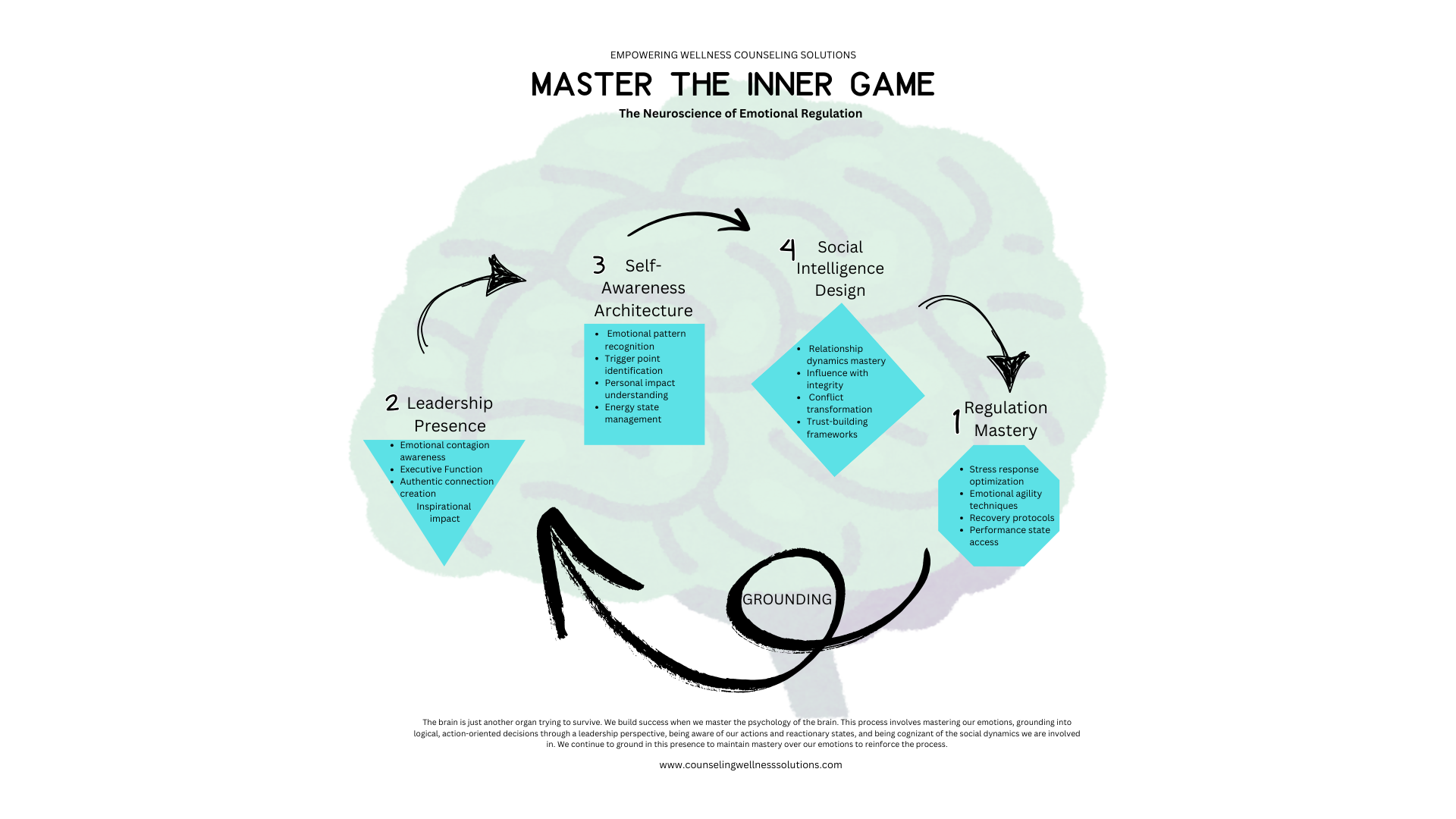The Science Of Stress Management
Jennifer Evans • November 14, 2024
Optimizing Stress To Win The High Stakes Game!

Stress management is a crucial component of success because unmanaged stress can hinder our productivity, well-being, and resilience. By managing stress, we can improve our focus, emotional regulation, and long-term health—each of which directly supports personal and professional achievements.
When we encounter stress, our body triggers the "fight-or-flight" response, a physiological reaction designed for survival. This response releases hormones such as cortisol and adrenaline, which prepare the body to react quickly. While beneficial in the short term, prolonged stress can disrupt multiple systems in the body and brain.
Chronic stress has been shown to:
Impact Cognitive Function: High cortisol levels can impair the prefrontal cortex, the part of the brain responsible for decision-making, problem-solving, and self-control. This makes it harder to stay focused and think critically, which are essential skills for success.
Affect Emotional Regulation: Chronic stress is linked to increased sensitivity to negative emotional states, often leading to irritability, anxiety, and feelings of overwhelm. Emotional regulation—staying calm and balanced despite challenges—is essential for success, as it allows for more effective interactions and decision-making.
Undermine Physical Health: Chronic stress can lead to health issues like hypertension, weakened immunity, digestive problems, and increased risk of chronic conditions like heart disease. Maintaining health is essential to success, as it provides the stamina and energy needed for sustained effort and productivity.
Decrease Resilience: Repeated exposure to stress without effective coping mechanisms can decrease our resilience over time, leaving us more vulnerable to stress in the future. Resilience is a key factor in achieving goals, as it allows us to persist despite obstacles.
The Role of Stress Management Techniques
Effective stress management involves techniques to reduce stressors and to regulate the body's stress response. Some evidence-based practices include:
Mindfulness and Meditation: These practices lower cortisol levels, promote relaxation, and improve emotional awareness. Mindfulness has also been shown to increase gray matter density in brain regions related to self-regulation, which supports emotional stability and resilience.
Physical Activity: Exercise reduces cortisol and releases endorphins, which improve mood and reduce the perception of stress. Regular physical activity enhances mental clarity, allowing individuals to tackle challenges with a fresh perspective.
Sleep Hygiene: Quality sleep is essential for stress management. Sleep helps the brain recover, process emotions, and consolidate memories. Studies show that people who sleep well can better handle daily challenges and remain calm under pressure.
Social Support: Engaging with supportive social networks helps regulate stress by releasing oxytocin, which counteracts stress responses. Supportive relationships encourage positive perspectives, reduce isolation, and foster resilience—all of which are foundational to achieving long-term goals.
Why Stress Management is Key to Success
Stress management not only supports physical and mental health but also cultivates habits that are foundational for success:
Focus and Clarity: With reduced stress, you’re more capable of concentrating on tasks and making sound decisions.
Emotional Stability: Managing stress enhances emotional resilience, enabling you to adapt to changes and manage setbacks with greater ease.
Increased Productivity: A well-regulated stress response conserves energy and focus, reducing burnout and enhancing productivity.
Ultimately, mastering stress management is not just about reducing stress—it’s about developing a mindset and lifestyle that fuel long-term growth, persistence, and success. Click Here To Access Our Stress Management Workbook.

Understanding your personal motivation style is like having a key to your own psychological engine. There are many things that drive us and hold us back. Behavioral Activation says, take one step forward and watch more steps follow. Motivation is the key to the momentum building step. Let's explore your motivation style. The Six Primary Motivators: Achievement Motivators are driven by accomplishment, progress, and mastery. They thrive on setting and reaching goals, measuring success, and continuous improvement. If you feel energized by checking items off lists and celebrating milestones, this might be your primary driver. Connection Motivators find their fuel in relationships, community, and making a difference for others. They're energized by collaboration, helping people, and being part of something larger than themselves. Recognition and appreciation from others significantly impacts their drive. Autonomy Motivators need freedom, choice, and self-direction. They're most energized when they can work independently, make their own decisions, and have control over their time and methods. Micromanagement is their kryptonite. Security Motivators are driven by stability, predictability, and safety. They find energy in clear expectations, consistent routines, and low-risk environments. They prefer proven methods over experimental approaches. Challenge Motivators thrive on novelty, complexity, and problem-solving. They're energized by difficult tasks, learning new skills, and overcoming obstacles. Routine work quickly drains their motivation. Recognition Motivators are fueled by acknowledgment, status, and appreciation. They need their contributions to be seen and valued by others. Public praise and visible success markers significantly boost their energy. Most people have a combination of these motivators, with one or two being dominant. The key is identifying your unique mix and designing your goals and environment to align with what actually energizes you, rather than what you think should motivate you. Want to discover your core motivators? Click Here To Access The Quiz

The Pillars of Success: Accountability, Dedication, and Purpose Success is not a single moment or event—it’s a lifestyle built on consistent choices, a resilient mindset, and meaningful values. While many factors can influence the path to success, three foundational pillars—accountability, dedication, and purpose—stand out as essential. Each serves a unique role in shaping a life of growth, achievement, and fulfillment. Among these, accountability is often the least glamorous, but it is the glue that holds the others together. Accountability: The Backbone of Success At its core, accountability is the willingness to take responsibility for your actions, behaviors, and outcomes—even when it's uncomfortable. It's about owning your decisions, following through on your commitments, and being honest with yourself and others. In the context of success, accountability is what transforms intention into action. You can have the strongest purpose and the fiercest dedication, but without accountability, those values remain ideas instead of reality. It helps you: Track progress: When you're accountable, you're actively measuring where you are versus where you want to be. Build trust: Whether with a team, a partner, or yourself, consistency and follow-through are the foundation of trust. Stay motivated: Knowing you're responsible for your results pushes you to keep going, especially when challenges arise. Correct course: Mistakes aren't failures—they're feedback. Accountability encourages reflection and adjustment, not denial or blame. Accountability doesn’t mean perfection—it means being present in the process and willing to confront the truth of your habits, patterns, and progress. Dedication: The Engine that Keeps You Going While accountability keeps you aligned, dedication is the inner drive that fuels the journey. Dedication is the choice to show up, even when it’s hard, inconvenient, or slow-moving. It’s what keeps you in the game after the excitement fades and the real work begins. True dedication means: Embracing the grind. Staying committed to the process, not just the outcome. Being consistent when motivation wanes. Dedication builds resilience, discipline, and character—qualities that no shortcut can replace. Purpose: The Compass that Guides You Purpose gives your work meaning. It’s the “why” behind your actions. Without purpose, even hard work can feel empty. But when you're connected to a greater purpose—whether it's serving others, fulfilling a personal mission, or building a legacy—your efforts become more powerful and sustainable. Purpose helps you: Stay focused during distractions. Make aligned decisions. Tap into intrinsic motivation rather than external validation. When your goals are tied to something bigger than yourself, your capacity to push through challenges multiplies. How the Pillars Work Together Imagine a three-legged stool: remove one leg, and it collapses. The same is true with accountability, dedication, and purpose. Accountability holds you responsible to your goals and values. Dedication fuels the long-term effort needed to reach those goals. Purpose keeps you focused on what truly matters. When all three are active in your life, success becomes more than a distant ideal—it becomes a sustainable and rewarding journey. Final Thoughts Success doesn’t just happen. It is built, brick by brick, with habits of responsibility, effort, and meaning. If you're looking to strengthen your foundation, start with accountability. Be honest with yourself. Track your commitments. Ask for feedback. And most importantly, take action—even small ones—with intention. Because when you hold yourself accountable, you stop waiting for success to happen—and start creating it.

The Funnel of Change: If you've ever committed to transforming some aspect of your life—whether it's a health goal, relationship pattern, career pivot, or mindset shift—you've likely experienced the frustrating cycle of initial progress followed by stagnation or backsliding. This isn't because you lack willpower or discipline. It's because you're trying to navigate change through the open-end of the funnel. The Negative Cycle is where we have a distressing thought/feeling/belief that we avoid which causes short-term relief and long term growth of low value, low capacity, and low motivation to want to better. While in this distress, we open ourselves up to over 2000 feedback loops that keep us in this distressed state. This where the funnel begins, we will be thrown out as soon as we avoid, leading us to feel more shame, guilt, and lack of control. The answer. Find purpose through outputs at each level. The more you are intentional, the more you can reach a positive flow state. LEARN MORE ON OUR YOUTUBE VIDEO Understanding the Funnel of Change Imagine personal transformation as a funnel—but not in the way you might expect. Most of us approach change from what I call the "open end" of the funnel: We focus exclusively on individual habits and behaviors We rely solely on personal willpower and motivation We keep our struggles and setbacks private We measure progress through isolated metrics We see transformation as a solitary journey This restricted approach creates a narrow channel for change—one easily blocked by life's inevitable challenges, internal resistance, or simple fatigue. Our natural propensity is to hop between these perceived control options, link to the language of discipline , and find ourselves in dichotomous situations. What if we've been approaching transformation backward? Flipping the Funnel: The Expansive Power of Community The most sustainable, profound transformations happen not at the open end of the funnel but at the restricted end—where individual change is held within a larger community context: Our personal goals connect to collective purpose Our individual willpower is supplemented by community accountability Our private struggles become shared challenges with communal wisdom Our isolated metrics expand to include relationship quality and contribution Our solitary journey transforms into a village expedition This isn't just philosophical—it's practical. Research consistently demonstrates that sustainable behavior change is dramatically more successful when embedded in supportive community. Finding community keeps us humble, vulnerable, and accountable to ourselves and others. This creates better opportunities for positive feed backing when we can stay in-tuned to our own internal value nature. How It Accelerates Transformation Reviewing our pillars for success we understand that purpose, dedication, and accountability is what allows for transformation. Here's why: 1. Neurobiological Reinforcement When we pursue change, our neurochemistry works with us rather than against us: Oxytocin (the bonding hormone) reduces stress and increases our capacity for difficult emotions Dopamine (the reward neurotransmitter) activates not just through achieving goals but through social recognition and celebration Cortisol (the stress hormone) decreases through co-regulation with trusted others These biological mechanisms create a more supportive internal environment for change. 2. Wisdom Beyond Experience Individual change is limited by our personal experience and perspective. In community: We learn from others' successes without having to personally discover every effective strategy We benefit from others' failures without having to make every possible mistake We gain access to diverse viewpoints that challenge our limiting assumptions We receive feedback that our isolated minds would never generate This collective wisdom accelerates our learning curve exponentially. 3. Sustained Motivation Through Meaning Individual motivation invariably fluctuates. Community provides motivational sustainability through: Connection to purpose larger than personal achievement The profound satisfaction of supporting others while being supported Accountability that comes from caring about the collective journey Identity reinforcement through belonging to a group with shared values When our personal changes contribute to a community we care about, motivation shifts from fleeting to foundational. Want your community to be within your own relationship? See how you and your partner can learn the unstoppable nature of the funnel framework. Click to sign up for our Masterclass. A Preview of What's Coming... In our in-depth Substack article, I'll take you deeper into the Funnel of Change framework, examining: The seven stages of transformation and how community influences each Common blockages at different points in the funnel and how to overcome them Practical strategies for intentionally designing your change efforts at the expansive end Real-life case studies of transformation accelerated through community A comprehensive assessment tool to evaluate where you're currently operating in the funnel This framework has revolutionized how my clients approach personal development—shifting from isolated strugglers to connected changemakers capable of sustained transformation. An Invitation As we prepare to dive deeper, I invite you to reflect: Where are you currently trying to create change through the restricted end of the funnel? How might approaching that same change through the expansive end transform your experience? What would it look like to build a village specifically around your most important transformation goals? Share your thoughts in the comments below, and join me tomorrow for the complete exploration of The Funnel of Change. The journey of transformation isn't just about feeling better—it's about becoming more capable of creating the changes that matter most in your life. [Subscribe to receive tomorrow's in-depth article directly in your inbox →] https://substack.com/@jennevans1

Breaking the Family Role Cycle: How Childhood Patterns Shape Anxious High-Achievers Are you constantly striving for perfection but never feeling good enough? Your childhood family role might be the hidden reason why. We all carry invisible scripts from our family dynamics into adulthood, but for anxious high-achievers, these childhood roles can become both a superpower and a curse. Understanding this connection is the first step toward breaking free from exhausting patterns and finding true fulfillment. LEARN MORE AT OUR YOUTUBE VIDEO! The Hidden Impact of Childhood Family Roles Research shows that family dynamics shape our adult behaviors in ways we rarely recognize. As children, we adopt specific roles to maintain family balance and earn love and approval. These roles become deeply ingrained in our personal development and continue influencing our adult relationships, career choices, and mental health. For those who identify as perfectionist high-achievers, these childhood patterns often manifest as: Chronic people-pleasing in professional settings Inability to celebrate accomplishments Persistent anxiety despite external success Imposter syndrome that no achievement can silence Difficulty setting boundaries in relationships Common Family Roles That Create High-Achievers The Responsible One If you were the de facto "third parent" in your family, you likely developed exceptional organizational skills and emotional intelligence. However, this role often leads to burnout and compassion fatigue in adulthood as you continue carrying everyone else's needs. The Academic Star When your value was tied to grades and achievements, you learned that performance equals love. This creates adults who excel professionally but struggle with perfectionism and work-life balance. The Family Peacemaker Mediators develop remarkable conflict resolution abilities but often at the cost of their own needs. This translates to adults who prioritize harmony over authenticity in their workplace culture. BREAK FREE: READ MORE ON HOW TO BREAK FAMILY ROLES YOU HAVE BEEN TAKING ON. Breaking Free: Healing for High-Achievers The path to personal growth begins with awareness. Recognizing these patterns isn't about blaming family - it's about understanding the emotional intelligence needed to rewrite these scripts. Self-compassion practices, mindfulness techniques, and therapy for high-achievers can help transform these unconscious patterns into conscious choices. Book an initial insight to learn how we can help. Moving Forward: From Survival Mode to Thriving True personal development means integrating the strengths these roles gave you while releasing the limitations. This journey toward authentic success requires: Redefining achievement beyond external validation Establishing healthy boundaries in relationships Recognizing worth independent of productivity Developing self-care routines that prioritize wellbeing These key points are also how we get out of deadly zone 3 trap. Read the learn about the Motivation Inverse Bell-Curve. Remember: You're not abandoning the remarkable qualities that make you successful - you're reclaiming them on your own terms. Ready to transform your relationship with achievement? Share your experience in the comments! Find this is damaging your relationships? Check out our self-paced Masterclass for Couples to build a happier and healthier self through your relationship. About the Author: Jennifer Evans is passionate about helping high-achievers find balance and fulfillment through understanding the psychology of childhood patterns. Sharing evidence-based strategies for authentic success and mental wellbeing. Check out our set on Performance Trauma The Language of Discipline Reward Systems Gone Arye Feedback Loops of Internal and External Validation

Mastering the Reverse Bell Curve of Motivation: A High-Achiever's Guide to Sustainable Excellence READ MORE AND ACCESS OUR MOTIVATION MAPPING TOOL T he Universal Pattern We All Experience You've felt it before. The surge of excitement when beginning a new project—ideas flowing, energy high, possibility seemingly limitless. Then, almost inevitably, comes the crash: that middle phase where progress slows, doubts creep in, and the finish line seems to stretch further away rather than closer. If you persist long enough, something remarkable happens: a second wind emerges, carrying you to completion with renewed vigor. This pattern—high, low, high again—forms what psychologists call the "reverse bell curve" of motivation. Unlike a standard bell curve that peaks in the middle, motivation often dips there instead. For high-achieving professionals, especially those prone to anxiety, this dip isn't just uncomfortable—it can trigger profound questioning of capability, purpose, and identity. The Science Behind the Curve Neurological Underpinnings The reverse bell curve isn't merely a psychological curiosity; it's rooted in neurochemistry. When we begin new endeavors, our brains release dopamine in anticipation of reward. This neurotransmitter fuels motivation and creates the initial rush of enthusiasm. However, as familiar psychologist Dr. Andrew Huberman notes, "Novel pursuits trigger dopamine release, but this effect diminishes as novelty wears off." In the middle phase of projects, dopamine levels naturally decline while the prefrontal cortex—responsible for executive function—must work harder to maintain focus without the chemical rewards. For anxious individuals, this transition is particularly difficult as the brain's threat-detection system (the amygdala) can interpret this natural motivation dip as danger. Psychological Components Beyond brain chemistry, several psychological mechanisms contribute to the reverse bell curve: Expectation vs. Reality Gap: Initial optimism often gives way to the realization that tasks are more complex than anticipated. Uncertainty Amplification: The middle phase typically contains the most unknowns, and uncertainty is particularly challenging for high-achieving, anxious professionals accustomed to control. Identity Threat: When progress slows, high-achievers often experience this as a threat to their self-concept as competent, effective individuals. Psychological Distance Effect: Goals seem psychologically further away in the middle phase, reducing their motivational pull. The High-Achiever's Amplified Experience For high-achieving professionals with anxious tendencies, the reverse bell curve often manifests with greater intensity. The initial phase may involve over-preparation and perfectionist planning. The valley phase frequently triggers impostor syndrome and catastrophic thinking. The recovery phase, if reached, can involve relief but also immediate concern about the next challenge. This amplification occurs because high-achievers typically: Hold themselves to exceptional standards Have built identities around consistent achievement Possess heightened sensitivity to performance fluctuations Experience stronger counterfactual thinking ("I should be doing better") Strategies for Navigating the Curve Phase 1: Capitalizing on Initial Enthusiasm Harness Without Over-Reliance Document insights and ideas during the "inspiration phase" Create structural scaffolding for when motivation inevitably dips Set realistic timelines that account for the coming valley Establish clear success metrics before emotional investment clouds judgment Practical Implementation: ACCOUNTABILITY- HARNESS YOUR WHY "I now keep a dedicated 'Project Genesis' document for every major initiative," shares Alex, a senior marketing executive. "I capture not just the plans but the emotional fuel—why I'm excited, what I envision. When motivation dips, I don't just have task lists; I have my original inspiration preserved." Phase 2: Valley Navigation Techniques The Valleys Are Where Mastery Is Built Micro-Progress Tracking: Break progress into the smallest viable units and track visibly. For anxious high-achievers, perceived progress significantly impacts motivation. Difficulty Shifting: Strategically alternate between challenging and manageable aspects of a project to maintain momentum. Anchoring Rituals: Develop consistent routines that signal to your brain it's time to engage regardless of emotional state. The 15-Minute Rule: Commit to just 15 minutes of focused work, after which you can reassess whether to continue. Discomfort Reframing: Recognize that the valley's discomfort isn't a warning sign but a normal part of the achievement process. Practical Implementation: THE POWER OF DEDICATION "I used to interpret motivation dips as evidence I was on the wrong track," explains Dr. Sarah Chen, research scientist. "Now I use what I call 'valley mapping'—I predict where motivation will dip and pre-script specific actions for those moments. My research productivity has increased by 40% since implementing this approach." Phase 3: Sustainable Momentum Building Creating Virtuous Cycles Implement completion rituals that reinforce identity as someone who finishes Extract learning protocols from each project cycle Balance recovery periods with momentum maintenance Develop transition strategies between projects to prevent post-completion crashes Practical Implementation: PURPOSE- FINDING ACCEPTANCE IS KEY "The biggest shift in my career came when I stopped treating motivation as something that happens to me and started treating it as a resource I actively manage," notes Jamie, a fintech entrepreneur. "I built what I call 'motivation infrastructure'—systems that support me through predictable energy fluctuations." Conclusion: From Surviving to Thriving The reverse bell curve of motivation isn't a character flaw or sign of inadequacy—it's a natural psychological pattern that affects even the highest achievers. For anxious professionals, understanding this pattern doesn't just provide relief; it offers a strategic advantage. By mapping your personal motivation patterns, implementing targeted interventions for each phase, and building sustainable systems, you can transform the curve from a liability into an asset. The goal isn't to eliminate the valley entirely but to navigate it with greater skill and less suffering. Want personalized guidance? Book a complimentary 15-minute strategy session to discuss your specific motivation challenges and receive tailored recommendations. https://calendly.com/counselingwellnesssolutions/free-15-minutes-wellness-insight

Relationship reconstruction: Apply your professional rigor to personal revival. Why Traditional Advice Falls Flat for Ambitious Couples You’ve read the relationship books. You’ve tried the date nights. You’ve even done the communication exercises. But somehow, the tension lingers—and the distance grows. Why? Because most relationship advice is not built for high performers. It doesn’t speak the language of metrics, systems, and intentional growth. You need more than emotional platitudes. You need a framework—a blueprint. This guide is designed for professionals who lead teams, manage portfolios, and solve high-stakes problems daily—yet struggle to apply that same strategic clarity to their most intimate partnership. Here’s how to reconstruct a relationship that doesn’t just survive, but elevates your life and career. 1. The Emotional Safety Imperative: Trust as Performance Infrastructure Research in neuroscience and attachment theory confirms it: Emotional safety is non-negotiable for growth. Without it, your nervous system operates in defense mode, shutting down empathy, creativity, and collaboration—both at home and at work. 🔒 Rebuilding trust means: Repairing ruptures quickly with clear accountability Practicing psychological attunement—listening without judgment Learning how to self-regulate so you can co-regulate as a couple 💼 Professional Parallel: Just like high-performing teams thrive on psychological safety, so do intimate relationships. When trust is restored, both partners perform better—personally and professionally. 2. Value Integration Engineering: Aligning What Matters Most In business, values drive culture and direction. Relationships need the same clarity. When individual values conflict or remain unspoken, disconnection deepens. 🧭 Use this method: Identify your top 5 personal values (e.g., freedom, stability, growth) Share them openly Co-create a Shared Value Map to define joint goals (e.g., “Build financial security and preserve adventure”) 🎯 This creates a relational compass that informs decisions, reduces conflict, and fosters mutual respect. 3. The Accountability Partnership: Structure Meets Vulnerability Accountability isn’t just for quarterly reports—it’s a powerful relationship tool. The goal is to blend structure with softness, ensuring both partners feel safe to show up fully. 🏗️ Tools to implement: Weekly “relationship check-ins” (What’s working? What needs attention?) Agreements instead of assumptions Transparent tracking of progress toward shared goals ❤️ Vulnerability thrives in containers. A predictable rhythm of connection creates emotional safety to be honest, make mistakes, and grow together. 4. Work/Life Integration: Beyond the Myth of Balance “Balance” often feels like a moving target—especially for high achievers. Instead, aim for integration, where your professional drive and relationship nourishment fuel each other rather than compete. 🔄 Integration strategies: Block out “sacred time” the way you would for a board meeting Share career wins and losses as a team—not as parallel lives Design your calendar around energy rhythms, not just availability 🌟 When your relationship supports your ambition (instead of being drained by it), you gain a multiplier effect on every goal you pursue. 5. Stress Optimization: Turning Pressure into Partnership Fuel Stress doesn’t have to be a relationship killer. In fact, properly harnessed, it can strengthen your bond. The key is not to eliminate stress—but to optimize your response to it. 💡 Practice: Identify personal “stress tells” (e.g., withdrawal, irritability) Create a “stress plan” as a couple: What do you need when you’re overwhelmed? Reframe challenges as shared missions: “How do we face this together?” 💼 Think of stress like a high-stakes presentation—handled with preparation, it sharpens focus and deepens trust. 6. Financial Alignment: Harmony in Wealth Building Money can be a minefield—or a master plan. Couples thrive when they align not just on numbers, but on financial philosophy. 💸 Financial wellness practices: Money dates: monthly reviews of spending, saving, and shared goals Agreement on roles: who does what, and why Emotional awareness: What did each partner learn about money growing up? 💰 Bonus: When financial conflict is resolved, couples often experience greater intimacy and increased energy for other life goals. 7. Health Synchronization: Wellness as a Team Sport Your body is your power source—for leadership, love, and longevity. Yet for many high achievers, health falls to the bottom of the to-do list. Synchronizing health goals can rebuild connection and increase energy. 💪 Start with: Shared fitness goals (e.g., a morning walk, gym date, sleep optimization) Emotional hygiene: meditation, therapy, or mindfulness together Supportive habits: help each other with burnout prevention and nutrition 🧬 Think of it as biohacking your relationship—upgrading your physical and emotional operating systems together. 8. Family Development Strategy: Planning for Life Transitions Just like you map out career milestones, you can plan for family transitions: children, aging parents, relocation, or retirement. This proactive approach prevents crisis-mode decisions. 📅 Build a strategic family plan: What’s your vision for the next 5, 10, 20 years? How will you divide parenting or caregiving roles? What life transitions need financial and emotional preparation? 🔮 Strategic foresight turns anxiety into agency. You don’t just react—you lead. Conclusion: The Competitive Advantage of Relationship Excellence Rebuilding your relationship isn’t just a personal win—it’s a professional edge. When your relationship becomes a source of energy, clarity, and emotional resilience, it amplifies your leadership, creativity, and long-term success. Just like you’d never run a business without a vision, a strategy, and aligned partners—don’t run your personal life without the same. True power isn’t found in solitude—it’s cultivated in strong, strategic connection. Build it. Nurture it. Lead it—with intention. Ready to Start? Join our Couples Masterclass and learn these principles and more! Still Have Questions? Book a FREE 15-Minute Insight to learn what is best for you. Remember, we can heal relationships with only one invested partner. The neuroscience-based framework is that powerful. Learning your half of the dynamic and neutralizing it will force the other partner to contend with their own dynamic.

Systems Thinking for the Soul As a high performer, you’ve likely been trained—formally or intuitively—to spot patterns, optimize systems, and engineer solutions. You recognize market trends, diagnose workflow inefficiencies, and anticipate team dynamics before they fully emerge. So why do relationships—particularly romantic ones—feel so unpredictable? The answer isn’t lack of intelligence or emotional capacity. It’s about translating your analytical strengths into the emotional domain. Relationships are not random; they operate within systems just like businesses do. With the right lens, you can map, diagnose, and transform your relational dynamics. This article is your blueprint for doing exactly that. 1. The Predictability Principle: Relationship Behaviors Follow Patterns Just like recurring pain points in a business process, relationships exhibit consistent feedback loops. Arguments follow the same arc. Distance and closeness dance in familiar rhythms. A Relationship Dynamics Assessment Tool can help you map these cycles—such as the protest-withdrawal loop or the overfunctioner-underfunctioner dance. 🔍 Key Insight: If you can track behavioral sequences in a quarterly report, you can learn to map your relational patterns. What happens before, during, and after conflict or emotional disconnection? Begin journaling these sequences like data points. 2 . Interaction Cycle Analysis: Zooming In on the Micro-Movements Every relationship operates on a stimulus-response loop. One partner’s comment triggers the other’s reaction, which loops back into the system. Over time, these interactions become predictable choreography. Use an Interaction Cycle Map to dissect recurring interactions: Trigger → Emotional Reaction → Behavior → Partner’s Reaction → Loop Example: Partner is late → You feel unimportant → You lash out → They shut down → You feel abandoned 🎯 Intervention Point : Learn to spot where you can pause the loop, either with a breath, a boundary, or a new behavior. 3. Conflict Resolution Engineering: Borrowing from Business Negotiation What if you handled emotional tension like a stakeholder negotiation? The most effective professionals know that tone, timing, and curiosity resolve more than force ever could. Conflict in relationships can be reframed as collaborative problem-solving. 🔧 Apply BATNA (Best Alternative to a Negotiated Agreement): What do you each really want beneath the surface complaint? Can you identify mutual goals (e.g., “We both want to feel heard”)? 🗣️ Practice: “Help me understand what’s really important to you in this.” “Can we find a solution that works for both of us?” 4. The Collective Unconscious in Partnership Carl Jung’s concept of the collective unconscious plays out in our relationships. Cultural scripts, generational trauma, and inherited belief systems shape our expectations—often without our awareness. You may be operating with an internalized “manual” for how love should look. 🧠 Business Analogy: Think of it as the legacy code in your software. Outdated but still running the show. 🛠️ Ask : What beliefs about relationships did I inherit from my family or culture? Are those beliefs helping or harming me now? 5. Family Role Reproduction: The Hidden Cast of Characters In childhood, we adopt roles (the caretaker, the achiever, the peacekeeper) to survive family dynamics. As adults, we unconsciously recast ourselves and our partners into these roles. 📌 Example: • If you were the “responsible one,” you might partner with someone emotionally erratic, replaying the parent-sibling dynamic. 👁️ Recognize the Pattern: What was your childhood role? Are you recreating it in your current partnership? 🎯 Choose Again : The beauty of pattern recognition is that it gives you the power to recode the system. 6. Neurological Precognition: The Brain’s Pattern-Matching Superpower Your brain is wired to predict behavior based on past data. That’s why you can sometimes finish your partner’s sentence—or preemptively shut down because you expect rejection. But this neurological efficiency can backfire when old fears overwrite new possibilities. 🧪 Practice: Pause and ask, “Is this my partner now, or my past speaking?” Invite curiosity over certainty: “What if I’m wrong about how they’ll respond?” 7. The Flow State Partnership: High Performance in Intimacy You know the feeling—when work flows effortlessly and time dissolves. Relationships can access this same optimal state when both partners feel safe, seen, and supported. 🧘♀️ Apply Peak Performance Principles: Clarity: Know your shared vision and values Challenge: Embrace growth edges without shaming Feedback: Give and receive real-time, constructive input 🌊 Relationships flourish when both partners are in sync and attuned, just like high-performing teams. Conclusion: The Competitive Advantage of Emotional Mastery As a high achiever, you already have the skills to master complex systems. Your relationship is simply a new terrain where those skills can shine—not through control, but through curiosity and consciousness. When you begin to see your relational patterns with the same clarity you bring to your career, you unlock a powerful truth: Emotional fluency isn’t just personal growth—it’s your next professional edge. By learning to navigate intimacy with the same sophistication you bring to business, you become more than successful. You become whole. Ready to begin? Join our Couple's Masterclass. It will dive deeply into these principles and many others as we write the next chapter in your love story. Still have questions? Book a FREE 15-Minute Insight and Learn all the ways we can support. Coaching can even fix a relationship when only one participant is willing.

You own your performance at work—but can you own your emotional impact in relationships? Many driven, successful professionals find themselves confused by the emotional chaos of intimate partnerships. The same skills that help you lead teams and manage crises often fall flat at home. That’s not a flaw—it’s a gap in emotional accountability. WATCH OUR YOUTUBE VIDEO AND LEARN MORE! In boardrooms and operating rooms, high-achievers excel at taking responsibility. They own mistakes, deliver results, and hold themselves to sky-high standards. Yet in intimate relationships, these same individuals often hit a wall. Why? Because emotional accountability—the art of owning your impact in a relationship—is a different skill set entirely. This paradox leaves many successful professionals confused: “Why can I lead a team of 100, but not resolve an argument with my partner?” The truth is, your professional strengths can become liabilities in personal dynamics—unless you learn to reorient them. The key? Learning to "own your side of the street." Elevate Your Relationship: Couples Masterclass on Accountability & Emotional Growth The Bad Brain Connection: Understanding Your Wiring Your brain is not just reacting to your partner—it's reacting to decades of programming. Attachment wounds, early modeling, and relational trauma form neural shortcuts that can hijack even the most self-aware person. That shutdown in conflict or the urge to over-explain? It’s likely not about your partner—it’s about your past. Recognizing these patterns is the first step toward rewiring your responses. Universal Constructs: What Every Relationship Faces Despite individual differences, most couples encounter the same core dynamics: the pursuer-distancer cycle, misaligned expectations, or unresolved ruptures. These aren’t signs of incompatibility—they're the architecture of intimacy. Learning to navigate them with awareness (instead of blame) moves your relationship from reactive to responsive. Key Insight: You’re not failing at love—you’re bumping up against a predictable pattern that requires new tools, not a new partner. The Hidden Grief Factor Many high-functioning professionals bury grief beneath productivity. But unresolved emotional losses—whether from past breakups, family dysfunction, or career sacrifices—can cloud present-day intimacy. Without naming these losses, we act them out in conflict, overprotection, or emotional distancing. BOOK A FREE 15 MINUTE CONSULTATION TO LEARN HOW YOU CAN BREAK FREE Reality Gaps: Bridging Perceived Truths In relationships, two people can experience the same moment—and walk away with entirely different interpretations. High-achievers often try to correct the other’s perception, unintentionally invalidating their reality. The Distress Tolerance Advantage Emotional regulation isn't about not feeling; it’s about staying present without reacting impulsively. When you increase your capacity to tolerate distress, you buy yourself time—to listen, reflect, and choose a response that fosters connection. The Professional’s Relationship Inventory Just like a quarterly performance review, your relationship needs reflection. Transferable Skills: From Boardroom to Bedroom Your strengths—strategic thinking, conflict resolution, self-discipline—are not liabilities in relationships. But they require translation. Analytical thinking can help decode emotional patterns, project management can become proactive relationship repair, and curiosity (not control) can become your superpower in intimacy. Conclusion: The Competitive Advantage of Emotional Ownership Owning your side of the street doesn’t mean taking blame for everything—it means recognizing your impact and responding with integrity. Emotional accountability is the next frontier for high-achievers who want success that extends beyond their careers. It’s not about perfection—it’s about presence. And it’s a competitive edge that transforms not just your relationships, but your life. Want More? Schedule A Free 15-Minute Wellness Insight. In this subscriber-only series, you’ll learn how to: Rewire reactive patterns shaped by your past Navigate universal relationship dynamics with clarity Use professional tools to improve emotional connection Turn your high standards into healthy intimacy Start owning your side of the street—and build the kind of relationship success that lasts. 👇 Subscribe now for full access 👇

You’re a high-performer. You know how to lead teams, solve complex problems, and get results. Your calendar is color-coded, your goals are tracked, and your inbox (mostly) under control. Professionally, you're thriving. But at home? That’s a different story. If you’ve ever wondered why your relationship feels harder than running a company—or why the same tools that make you successful in business seem to fall flat in love—you’re not alone. In fact, it’s more common than you think. Here’s the paradox: ✅ You’re capable, disciplined, strategic. ❌ But you feel misunderstood, disconnected, or overwhelmed in your relationship. ✅ You can communicate clearly at work. ❌ But arguments with your partner escalate or go nowhere. ✅ You’ve read the books, listened to the podcasts. ❌ Yet things still feel stuck. Why? Because most relationship advice isn’t made for high-achievers. It assumes you’re passive, unaware, or lacking discipline. But that’s not your problem. The problem is translation. What makes you powerful at work—goal-setting, problem-solving, independence—can get in the way when it comes to intimacy, emotional safety, and vulnerability. It creates an altered dynamic that is hard to get out of-making your partner feel they don't own space in the relationship. But what if you could retrain those same strengths for your relationship? What if leadership, emotional intelligence, and systems thinking could become tools for connection—not just productivity? Access our substack subscription and explore: 📌 The hidden attachment patterns behind success-driven behavior 📌 Why mindfulness is the fastest way to better communication (in 5 minutes or less) 📌 The four communication mistakes that quietly kill relationships (and how to replace them) 📌 How to treat boundaries like a business skill 📌 A complete system for creating connection without sacrificing performance 👉 [ Subscribe now to read the full article →] In a world that rewards hustle, connection is your secret edge. Relationship intelligence enhances your leadership, stabilizes your personal life, and protects your most vital resource: your emotional well-being. If you’re ready to apply your high-performance mindset to your most important partnership, our Couples Masterclass is your next move. Think of it as professional development—for your relationship. Because the real measure of success isn’t just what you build. It’s who you build it with. Because you don’t need to choose between achievement and intimacy. You just need a framework that fits you. Want more? Schedule a FREE 15-minute Wellness Insight.

You’re driven, thoughtful, and accomplished. You hold yourself to high standards. You want to be great—at everything, including love. But in relationships, things feel… harder. ACCESS OUR YOUTUBE TO LEARN MORE You find yourself: Feeling responsible for keeping things “together” Avoiding vulnerability even though you crave connection Attracting partners who seem overly emotional or “too much” Swinging between perfectionism and procrastination in the relationship If this sounds familiar, you’re not alone—and you’re not broken. You may be an anxious high-achiever with an avoidant attachment style. And the patterns you're stuck in? They're deeply wired—but completely transformable. 🧠 What Is an Anxious High-Achiever? An anxious high-achiever is someone who: Bases self-worth on performance Struggles to rest, ask for help, or tolerate emotional “mess” Over-functions in most areas of life—but under-feels in relationships This often stems from childhood environments where love was conditional, inconsistent, or earned through success. So, as adults, love = pressure. “If I’m not perfect, I’ll be rejected.” “If I show too much need, I’ll be a burden.” To cope, many anxious high-achievers develop avoidant attachment strategies—appearing self-sufficient, distant, or emotionally controlled in order to stay safe. 💞 Why You Attract Anxiously Attached Partners Here’s where it gets interesting. If you lean avoidant, you often attract partners who lean anxious in their attachment style. Why? Your self-control feels stable to them. Their emotional intensity feels alive to you. Underneath both patterns is the same fear: abandonment. But together, this pairing often triggers a painful loop: The anxious partner reaches out for closeness. The avoidant partner withdraws to preserve autonomy. The anxious partner panics, pursues harder. The avoidant partner shuts down or distances further. Now you’re both performing, protecting, and reacting—instead of relating. 🎭 How This Ties to the Performance-Procrastination Spectrum As a high-achiever, you likely swing between: Perfectionism (over-functioning, over-controlling) Procrastination (emotional withdrawal, avoidance, shutdown) In love, this might look like: Delaying hard conversations Ghosting your own feelings Waiting for the “right” time to open up Rehearsing the perfect thing to say—but never saying it It’s not because you don’t care. It’s because deep down, you fear: “If I can’t do this perfectly, I’ll lose everything.” But perfection is a wall—not a bridge. 🧭 The Way Out: From Performing to Partnering Healing this dynamic requires more than insight—it takes new relational skills that feel safe for both partners. Here’s how to start: 1. Identify Your Core Trigger Pattern Learn your default strategy: Do you shut down? Over-talk? Over-analyze? Awareness is the first step to shifting. 2. Pause the Performance Loop Before reacting, pause and check: “Am I protecting myself, or participating in this relationship?” Choose small moments to lean in instead of lean out. 3. Validate Each Other’s Needs Anxious partners need reassurance. Avoidant partners need space that doesn’t cost connection. You both need a new emotional language. 📘 Ready to Break the Pattern? Start with the Couples Masterclass If you see yourself in this cycle and want a grounded, attachment-informed way out, the Couples Masterclass Self-Study is for you. Inside, you’ll learn: • How to recognize and rewire your attachment dynamics • Tools to communicate without triggering shutdown or panic • Ways to shift from reactivity to connection • Scripts, exercises, and healing rituals to rebuild trust and safety You don’t need to be perfect to love or be loved. You just need a new map—and a willingness to practice. ❤️ Final Thought: Relationships are not performance reviews. You don’t need to be flawless. You need to be real. If you're an anxious high-achiever stuck in an avoidant-anxious loop, know this: You’re allowed to unlearn survival and start choosing connection. Your nervous system might need structure and safety—but your heart still craves closeness. You don’t have to choose between the two. LEARN MORE ABOUT OUR COUPLES MASTERCLASS. A SELF-PACE INTERACTIVE COURSE TO LEARN THE FOUNDATION OF HEALTHY RELATIONSHIPS, HOW YOU ARE LIVING IN YOUR HALF OF THE DYNAMIC, AND HOW TO BUILD A NEW LOVE STORY TOGETHER.

